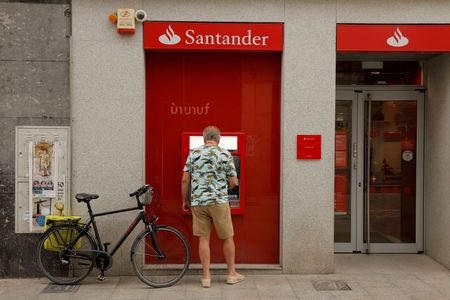By Jesús Aguado
MADRID (Reuters) – Higher loan loss provisions in some of Santander’s key markets, such as Brazil and the United States, and a rise in costs overshadowed better than expected third-quarter earnings at the Spanish bank, knocking its shares on Wednesday.
Strong profitability in the Americas still helped the bank, the euro zone’s second-biggest by market value, to deliver a 11% rise in quarterly net profit to 2.42 billion euros ($2.43 billion), beating analysts’ mean forecast of 2.19 billion euros.
But loan loss provisions jumped 24% to 2.76 billion euros.
While that was in line with expectations, investors are jittery about the impact of a global economic downturn on banks, with several U.S. lenders recently setting aside more money in anticipation of tougher times.
“We expect the macroeconomic environment to remain challenging as markets across Europe and North America adapt to levels of inflation not experienced in decades,” Santander’s Chairman Ana Botin said in a statement.
The bank’s shares were 4.8% down in morning trade, lagging Spain’s blue-chip index, which fell 0.21%.
Santander’s cost of risk, which measures the cost of managing credit risks and potential losses for the bank, rose to 86 basis points from 83 at the end of June, but was still below the 100 basis points it has set as a guidance for the year.
In its U.S. unit, underlying net profit fell 17.5% against the same quarter last year as impairments rose more than 74%.
“While it is true that the deterioration in Brazil and the United States were in line with the bank’s guidance, the doubts about their performance might not please the market,” Nuria Alvarez, analyst at Madrid-based brokerage Renta 4, said.
COSTS
Revenues rose 13% in the third quarter against the same quarter last year, while net interest income (NII), a measure of earnings on loans minus deposit costs, rose 19% year-on-year to 10.05 billion euros, beating forecasts for 9.78 billion euros on the back of higher interest rates.
Inflationary effects, particularly in South America, led to an increase of 8.5% year-on-year in costs in constant currencies in the third quarter at a group level.
In Brazil, which accounts for more than quarter of group earnings, underlying net profit rose 14% year-on-year, but NII fell 1.2% against the previous quarter.
Cost of risk in Brazil rose to 446 basis points from 426 points in the previous quarter, while provisions rose more than 50% year-on-year.
In Britain, which accounts for 17% of group earnings, underlying net profit fell 9.3% on higher impairments, in contrast to Spain, where net profit more than doubled on lower provisions.
In terms of solvency, Santander’s tier-1 fully loaded capital ratio, the strictest measure of solvency, rose to 12.10% at the end of September, above the group’s target of 12%.
Santander said it was on track to meet the 2022 targets, such as mid-single digit revenue growth and an underlying return on tangible shareholders’ equity of above 13%.
Regarding its cost-to-income ratio, Santander said it was close to its target of 45% despite inflationary pressures after it finished September at 45.6%.
($1 = 0.9972 euros)
(Reporting by Jesús Aguado; additional reporting by Emma Pinedo; Editing by Inti Landauro and Mark Potter)

